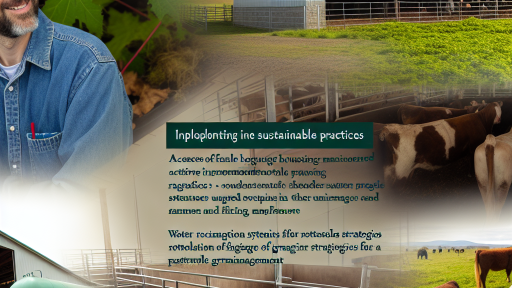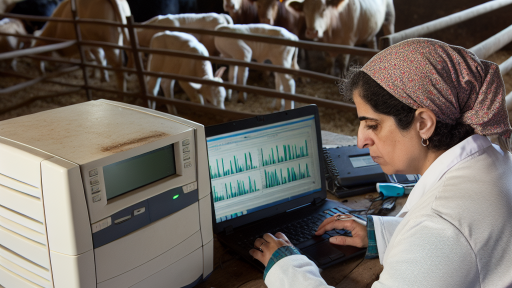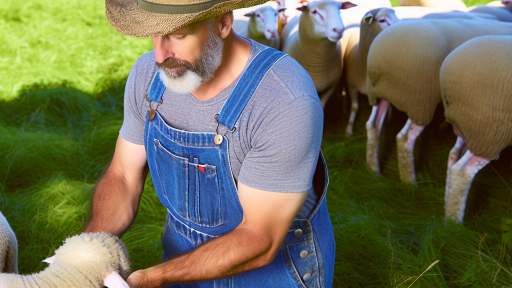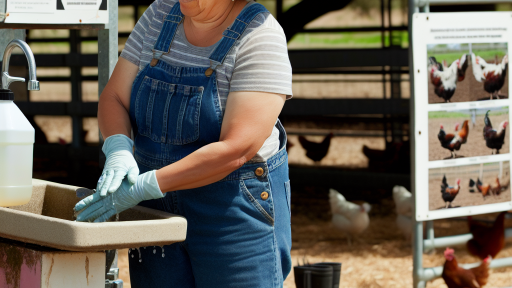Introduction to Flooring Options for Livestock Housing
Choosing the right flooring for livestock housing is crucial for animal welfare.
Proper flooring enhances comfort and safety for livestock.
Additionally, it simplifies maintenance and hygiene management.
Different materials offer unique benefits and challenges.
Each type of flooring suits specific livestock species and farming conditions.
Understanding flooring options can guide farmers in making informed decisions.
Factors to Consider in Flooring Selection
Several factors influence the choice of flooring materials.
The first factor is animal type and behavior.
Cattle, pigs, and poultry have different flooring needs.
Next, consider the climate and environmental conditions.
Local weather affects how flooring materials perform.
Certain materials may be more suitable in wet or dry climates.
Furthermore, evaluate maintenance requirements for each flooring type.
Some materials demand more upkeep than others.
Finally, assess budget constraints and long-term cost implications.
Transform Your Agribusiness
Unlock your farm's potential with expert advice tailored to your needs. Get actionable steps that drive real results.
Get StartedCommon Flooring Materials
Various materials are widely used for livestock flooring.
Concrete is one of the most popular options.
It offers durability and ease of cleaning.
However, concrete can be hard on animals’ feet.
Rubber flooring provides comfort and traction for livestock.
This material helps minimize injuries from slips and falls.
Wooden floors are another traditional choice.
They are warm and provide good insulation.
On the downside, wood requires proper maintenance to prevent decay.
Eco-friendly options, like recycled rubber, are also gaining popularity.
These materials combine sustainability with performance benefits.
Benefits of Proper Flooring
Investing in quality flooring positively impacts livestock health.
Comfortable flooring reduces stress and improves overall well-being.
Moreover, good flooring supports better productivity in livestock.
Reduced risk of injuries leads to fewer veterinary costs.
It also maintains optimal hygiene levels, preventing disease outbreaks.
Consequently, proper flooring contributes to better farm efficiency.
Importance of Choosing the Right Flooring for Animal Health and Safety
Impact on Animal Health
The flooring of livestock housing significantly affects animal health.
Poor flooring can lead to injuries and stress among animals.
Hard or slippery surfaces increase the risk of injuries.
Inadequate materials can harbor diseases and parasites.
Choosing the right flooring promotes better hygiene and comfort.
Safety Considerations
Animal safety is crucial in livestock housing.
Proper flooring reduces the risk of slips and falls.
Showcase Your Farming Business
Publish your professional farming services profile on our blog for a one-time fee of $200 and reach a dedicated audience of farmers and agribusiness owners.
Publish Your ProfileIt also minimizes the likelihood of foot injuries.
Additionally, it provides stable footing during movements.
Soft, non-slip surfaces enhance overall safety.
Influence on Productivity
The right flooring contributes to higher productivity levels in livestock.
Comfortable animals perform better and produce more efficiently.
Inappropriate flooring may lead to stress and reduced feed intake.
Healthy, comfortable animals exhibit improved growth rates.
Therefore, investing in quality flooring systems pays off.
Factors to Consider When Choosing Flooring
Several factors influence the choice of flooring for livestock housing.
The type of livestock plays a significant role in selection.
For instance, cows may require different flooring than pigs.
Evaluate the climate and environment of the housing area.
Consider maintenance and cleaning requirements for each flooring option.
Costs should also be a factor in the flooring decision process.
Overview of Traditional Flooring Materials
Wood Flooring
Wood flooring has been a traditional choice for livestock housing.
This material offers natural insulation and comfort.
However, wood can wear down quickly under heavy use.
Moreover, it is susceptible to moisture and decay.
Concrete Flooring
Concrete flooring is popular due to its durability and strength.
This material can withstand the weight of livestock with ease.
Additionally, concrete is easy to clean and maintain.
However, it can be hard on the animals’ feet.
This rigidity may lead to discomfort over time.
Rubber Flooring
Rubber flooring provides excellent cushioning for livestock.
This material reduces the impact on joints and hooves.
Furthermore, rubber mats can enhance grip, preventing slips.
Yet, initial costs may be higher compared to traditional options.
Additionally, rubber can be prone to damage from sharp objects.
Sand Flooring
Sand flooring offers a natural and effective bedding option.
It provides a comfortable surface for animals to rest on.
Moreover, sand promotes good drainage and reduces odor.
However, it requires regular replacement for cleanliness.
With time, loose sand may create uneven surfaces.
Tile Flooring
Tile flooring is another option for livestock housing.
This material is durable and easy to clean.
Additionally, tiles can be designed with various textures for safety.
However, tiles can retain coldness during winter months.
Furthermore, they may crack under heavy impacts.
Choosing the Right Material
Each flooring option has its advantages and disadvantages.
When choosing, consider the specific needs of your livestock.
Showcase Your Farming Business
Publish your professional farming services profile on our blog for a one-time fee of $200 and reach a dedicated audience of farmers and agribusiness owners.
Publish Your ProfileAlso, think about the maintenance requirements of each material.
Cost and long-term durability should influence your decision.
Finally, aim for a balance between comfort and practicality.
Explore Further: Choosing The Right Waste Management System
Advantages and Disadvantages of Concrete Flooring
Key Advantages
Concrete flooring offers durability and strength.
It withstands heavy loads and impacts effectively.
This option also resists moisture and pests.
Consequently, it reduces maintenance concerns.
Moreover, concrete surfaces are easy to clean.
This feature helps maintain a healthy environment for livestock.
In addition, concrete can be customized in various finishes.
This customization allows for aesthetic appeal in livestock housing.
Notable Disadvantages
Despite its many benefits, concrete has drawbacks.
It can become slippery, especially when wet.
This slipperiness poses a risk for animals and workers alike.
Furthermore, concrete can retain heat, leading to discomfort.
In colder climates, concrete may become uncomfortably cold for livestock.
This flooring type also lacks natural insulation.
As a result, it may require additional heating in winter months.
Finally, installation can be costly and time-consuming.
Considering Alternatives
Before choosing concrete, explore other flooring options.
Some alternatives include rubber, wood, and sand.
Each alternative has its unique advantages and challenges.
Evaluate these options based on specific needs and conditions.
You Might Also Like: Optimal Housing Solutions for Beef Cattle
Benefits of Rubber Flooring in Livestock Barns
Durability and Longevity
Rubber flooring is known for its impressive durability.
It withstands heavy traffic from livestock without damage.
Moreover, rubber surfaces do not crack under pressure.
This longevity ultimately reduces replacement costs.
Comfort for Animals
Rubber flooring provides a cushioned surface for animals.
This cushioning minimizes the risk of injuries and falls.
Additionally, it reduces fatigue during standing or walking.
Consequently, animals remain healthier and more active.
Improved Hygiene
Rubber flooring is easy to clean and maintain.
The non-porous surface helps prevent bacteria growth.
Furthermore, it can be sanitized easily with standard cleaning solutions.
This feature enhances overall barn hygiene significantly.
Temperature Control
Rubber flooring offers excellent insulation properties.
This insulation keeps the barn warmer in winter months.
Additionally, it remains cooler in summer conditions.
Showcase Your Farming Business
Publish your professional farming services profile on our blog for a one-time fee of $200 and reach a dedicated audience of farmers and agribusiness owners.
Publish Your ProfileSuch temperature regulation ensures animal comfort year-round.
Noise Reduction
Rubber surfaces help dampen noise levels in barns.
This noise reduction contributes to a calmer environment.
Animals experience less stress, leading to improved well-being.
Slip Resistance
Rubber flooring provides superior traction even when wet.
This feature significantly reduces the risk of slips and falls.
As a result, both animals and workers stay safer.
Therefore, rubber flooring promotes a secure working environment.
Environmentally Friendly Option
Many rubber flooring options are made from recycled materials.
This eco-friendly attribute contributes to sustainability efforts.
Additionally, using rubber reduces the reliance on natural resources.
Thus, choosing rubber flooring benefits both livestock and the planet.
Explore Further: Energy Efficient Livestock Housing Designs
Natural Flooring Options
Straw
Soy is a popular flooring option for livestock housing.
It provides natural cushioning for animals.
Additionally, soy is excellent for moisture absorption.
This helps maintain a healthier environment in barns.
However, it requires regular replacement to prevent odor build-up.
Sawdust
Sawdust serves as an effective flooring material as well.
It offers good absorbency, keeping the area dry for animals.
Moreover, sawdust can help control odors.
The texture provides comfort underfoot for livestock.
On the downside, it should be sourced from untreated wood.
Grass
Grass can be used as a flooring option in outdoor housing.
It offers a natural habitat for grazing animals.
Furthermore, grass promotes better animal health.
However, it may not be suitable for all seasons.
Regular maintenance is necessary to keep it lush and healthy.
Find Out More: Sheep Breeding Strategies for Optimal Lambs
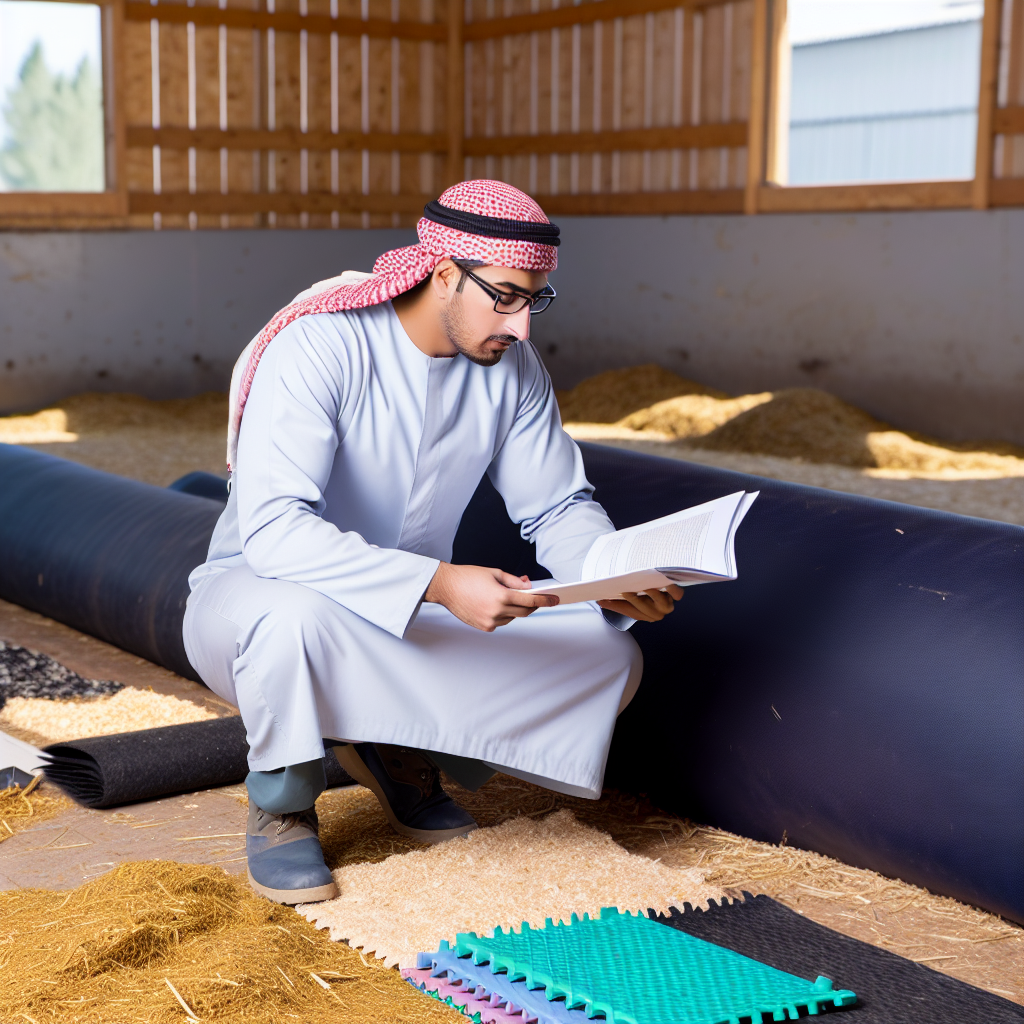
Comparative Analysis of Flooring Options for Livestock Housing
Introduction to Flooring Types
Selecting the right flooring type is crucial for livestock housing.
Different materials offer varied benefits in terms of cost and durability.
This analysis explores major flooring options available in the market.
Concrete Flooring
Concrete is one of the most common flooring options for livestock housing.
It is durable and can withstand heavy loads.
Nevertheless, it can be hard on the animals’ joints.
Moreover, concrete requires proper drainage to avoid moisture accumulation.
Costs for concrete flooring can be moderate to high, depending on thickness.
Rubber Matting
Rubber matting offers excellent comfort and traction for livestock.
This flooring type helps reduce the risk of slips and falls.
Rubber is also beneficial for cushioning, potentially lowering injury rates.
Showcase Your Farming Business
Publish your professional farming services profile on our blog for a one-time fee of $200 and reach a dedicated audience of farmers and agribusiness owners.
Publish Your ProfileHowever, it can be expensive to install and replace over time.
The initial cost may be higher than more traditional options.
Wood Flooring
Wood flooring provides a warm and natural environment for animals.
It is less abrasive than concrete, promoting better animal welfare.
However, wooden floors can suffer from rot and require maintenance.
Costs vary significantly based on wood type and treatment methods.
While initial investments can be lower, long-term upkeep may add costs.
Sand Flooring
Sand flooring is popular in certain livestock facilities.
This type offers good drainage and minimizes ammonia buildup.
It is also relatively inexpensive compared to other options.
However, sand can shift and requires frequent replenishment.
Overall, sand flooring is cost-effective but needs proper management.
Comparative Cost Analysis
When considering costs, initial installation versus longevity is key.
Concrete and rubber tend to have higher initial costs but long lifespans.
Wood and sand may save money upfront, but maintenance can add up.
Always evaluate local prices and availability for any flooring option.
Durability Considerations
Durability is vital for ensuring long-term livestock housing success.
Concrete ranks high in durability but lacks comfort.
Rubber matting lasts long but can degrade over time.
Wood flooring has a finite lifespan due to wear and environmental factors.
Sand’s durability is heavily dependent on management practices.
Implications of Proper Flooring Selection
Choosing the right flooring involves weighing costs against durability and comfort.
Consider the specific needs of your livestock when making a decision.
Ultimately, the best flooring enhances animal welfare and operational efficiency.
Maintenance Requirements for Various Flooring Options
Concrete Flooring
Concrete flooring is popular due to its durability.
Regular cleaning is essential to maintain hygiene.
Use a pressure washer for occasional deep cleaning.
Check for cracks and repair them promptly to prevent further damage.
Seal the concrete periodically to enhance water resistance.
Wooden Flooring
Wooden flooring requires careful maintenance for longevity.
Regular sweeping removes dirt and debris effectively.
Wet mopping should be done sparingly to avoid water damage.
Inspect for signs of wear and sand down surfaces as needed.
Apply a protective finish annually to preserve the wood.
Rubber Flooring
Rubber flooring is resilient and ideal for livestock housing.
Routine cleaning with a mild detergent keeps it hygienic.
Replace any damaged tiles to maintain a safe environment.
Check for slip resistance and adjust if necessary to prevent falls.
Regularly inspect for signs of wear, especially in high-traffic areas.
Deep Straw Bedding
Deep straw bedding offers comfort for livestock.
Showcase Your Farming Business
Publish your professional farming services profile on our blog for a one-time fee of $200 and reach a dedicated audience of farmers and agribusiness owners.
Publish Your ProfileRegularly add fresh straw to maintain cleanliness and comfort.
Remove soiled straw promptly to reduce odor and bacteria.
Compost the used straw for beneficial use in farming.
Inspect the bedding regularly to ensure it remains dry and clean.
Sand Flooring
Sand flooring is a natural option that requires minimal upkeep.
Regular raking keeps the surface level and comfortable.
Add fresh sand periodically to maintain the desired depth.
Monitor for signs of moisture retention and address drainage issues.
Ensure it remains clean to prevent health risks for the livestock.
Regulatory Considerations and Best Practices for Flooring in Livestock Housing
Understanding Regulations
Livestock housing must comply with various regulations.
These regulations focus on animal welfare and environmental impacts.
Different regions may have specific guidelines to follow.
For example, the USDA has established standards for flooring materials.
Consult local authorities to ensure compliance with all requirements.
Choosing Appropriate Materials
Select materials that promote both safety and comfort for animals.
Consider durable options such as concrete, rubber, or wood.
Each material has unique properties that influence usability.
For instance, rubber provides excellent traction and cushioning.
On the other hand, concrete is robust and easy to clean.
Ensuring Cleanliness and Hygiene
One key aspect of flooring is maintaining cleanliness.
Choose materials that allow easy waste removal.
Additionally, various flooring innovations help improve hygiene.
For instance, slatted floors can facilitate waste management effectively.
Regular cleaning routines are vital for health and safety.
Incorporating Proper Drainage
Effective drainage systems are critical in livestock housing.
Consistent moisture management can prevent disease outbreaks.
Plan the flooring layout to enhance drainage capabilities.
Elevated surfaces or slopes can help direct liquids away.
Incorporating drainage channels can also be beneficial.
Considering Temperature Control
Temperature regulation is essential for livestock comfort.
Some flooring materials retain heat better than others.
For example, bedding over concrete can provide insulation.
Evaluate seasonal climate variations when selecting materials.
Consider heating systems for cold weather to promote welfare.
Involvement of Professionals
Consulting with experts can enhance flooring decisions.
Veterinarians can provide insights into animal health needs.
Architects can ensure the structure supports efficient layouts.
Collaboration leads to more functional livestock environments.
Moreover, seek advice from contractors familiar with animal housing.
Additional Resources
Guide for the Care and Use of Laboratory Animals, 8th edition …
Showcase Your Farming Business
Publish your professional farming services profile on our blog for a one-time fee of $200 and reach a dedicated audience of farmers and agribusiness owners.
Publish Your ProfileSymposium review: Future of housing for dairy cattle – Journal of …

